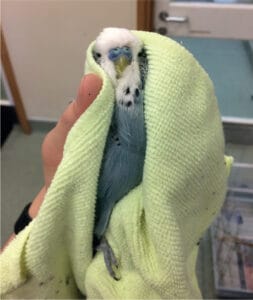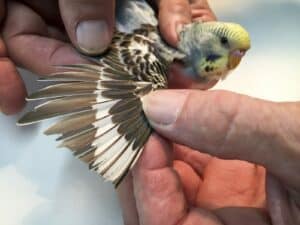Hey everyone, if you’re a proud parakeet owner like me, you know how important it is to keep our feathered friends happy and safe.
One crucial aspect of their care is knowing how to clip and trim their wings properly.
In this article, I’ll guide you through the process of safely and effectively clipping your parakeet’s wings, ensuring they can enjoy their freedom indoors while staying out of harm’s way.
Let’s get started on this essential journey of responsible pet ownership!
Clipping or trimming a Parakeet’s wings may seem a little tough and daunting task, and indeed it will require your patience and some time to practice. Clipping and trimming your bird can be risky when in the wrong hands, as it requires steady good hands that are able to minimize hazards and panic to reduce any risk and get the job done.
How to Clip a Parakeet’s Wings?
Here we will show you some processes with the help of which you can clip your Parakeet’s wings very easily.
This guide will save you time and money, so you won’t need to visit any veterinarian doctor or any advisor; you can do it on your own.
For completing the task all by yourself, you have to always take care of the safety measures before taking a step because your one mistake can cause you a huge loss.
Don’t try to become nervous when you are following the below-mentioned easy steps to clip and trim your Parakeet’s wings.
Otherwise, you can face the risk of serious harm to your pet.
1. Keep a First Aid Kit with You
Despite the fact that you realize you will do all that you can to limit the danger of injury to your Parakeet.
Before you start clipping your parakeet wings, keep an emergency first aid kit (Get it from Amazon) and keep it near you.
In case of an unexpected event, it will be useful for you to have speedy admittance to rescue or help your pet with a heap of clinical supplies.
2. Select a Quiet Location
Noise pollution can always spoil the mood of a person, and it can scare your pet as well.
Picking a decent area for you to take away your Parakeet’s wings for clipping and trimming will help keep your pet as quiet as conceivable during the process.
Attempt to pick an area away from your pet’s enclosure, away from any noisy, unexpected commotions, and away from any traffic area.
Keeping them distant from noisy areas will keep them calm; otherwise, they can react or bounce back to fight or flap their wings while getting them trimmed which can harm them very badly.
3. Restrain your Parakeet

Holding your Parakeet in a cloth-like towel or something more soft and comfortable will help you to relax your pet and give you a more secure and restrained position to inspect its wings properly so that you can continue the trimming process.
4. Gather the Required Supplies
You should get your supplies ready when you are done dealing with the environment and other factors that may disturb you while clipping the feathers of your parakeet.
The following are required instruments for this purpose:
- A pair of scissors that are sharp enough to easily cut the feathers
- A thick towel to hold the parakeet comfortably in your hands
- An assistant for the clipping and trimming process.
5. Clipping Feathers
Now we move to the clipping process.
The most proficient and viable strategy is to cut just the initial five essential quills on every one of your Parakeet’s wings.
When managing the feathers, be certain that you utilize sharp scissors and try not to cut into feather shafts that seem dull in shading.
A dull feather shows a blood plume, which can cause difficult issues whenever broken or cut.
6. Starting at Wing Tip

You can start the clipping process from the primary feathers of your parakeet.
These feathers are overlapping other feathers about a quarter inch below the shorter wings.
7. Cutting One Feather at a Time
Clipping the parakeet’s wings can be tough and you should use sharp scissors with precision and concentration to properly cut the feathers.
If you try to quickly cut the feathers, you may cut the blood feathers or destroy all the other feathers resulting in hurting your parakeet very badly.
8. Watch Out for Blood Feathers
The blood feathers are a sensitive part of a bird’s body and they can cause harm to your pet if broken or cut.
You have to stay overprotective while cutting the wings to avoid the blood feathers of your parakeet.
And you should also avoid clipping the feather next to it.
9. Trim Equal Feathers
You should be careful about which feathers you have to clip from the front and back of your Parakeet’s wings.
The feathers need to be cut equally from both sides.
If you don’t cut them with a proper balance, this may cause your bird to not fly properly.
You can just focus on trimming from 4 – 8 feathers of your Parakeet, which are in the bottom layer from outside in the position of its wings.
You should not clip the secondary feathers, which are after the 10th number of feathers.
Does Parakeet Wings Clipping and Trimming Hurt?
It is a common question asked by most people because some parakeet owners don’t want to clip or trim the wings of their pet because they think it may cause harm or damage to the bird.
It is just like clipping your nails that don’t cause any harm or pain in the fingers.
The Parakeet doesn’t feel anything when feathers are clipped or trimmed.
But you do need to keep one thing in your mind over-clipping your bird’s wings is not necessary; it will affect the gliding of the bird in the future.
This can lead them to fly in a forward direction only and not upwards, due to which they can crash and get a very serious injury.
When to Clip or Trim the Feathers of Parakeet?
It can be difficult for a bird owner to know when should he trim the feathers of his Parakeet.
You can try a little test that we will suggest; it may help you to know if the feathers require trimming or not.
You can roost the Parakeet in your hand a couple of feet over a covered floor.
Bringing down your arm abruptly, yet cautiously, will make the Parakeet fold its wings, and it will either shudder to the floor or coast smoothly away.
Parakeets who can coast starting with one area and then onto the next need to have the feathers cut once more.
In case it’s been some time since the last time you clipped your bird’s Parakeet’s wings, you can obviously see that the long essential feathers of your Parakeet have grown back, and you will need to trim them.
When Not to Clip Feathers of Parakeet?
Small or baby parakeets should figure out how to fly before their feathers are cut or trimmed so they can create their equilibrium balance and nimbleness.
It is recommended to not trim or clip your Parakeet’s wings until it does feel necessary.
In case you’re apprehensive, or your pet is furious or wriggling, think about visiting a veterinarian first to get professional advice for your Parakeet in the first place.
Conclusion
In conclusion, learning how to clip and trim your parakeet’s wings is a vital skill for any responsible bird owner.
By following the proper techniques and guidelines, you can provide your feathered companion with a safe and enriching environment within your home.
Remember, wing clipping should be done with utmost care and consideration for your parakeet’s well-being.
It’s not about limiting their freedom, but rather ensuring their safety, especially in indoor spaces where potential hazards exist.
Regular wing trims can also facilitate trust-building and training sessions, strengthening the bond between you and your parakeet.
However, it’s essential to be patient and gentle during the process to avoid causing stress to your beloved pet.
If you’re unsure about wing clipping, seeking advice from a knowledgeable avian veterinarian or a professional bird groomer is always a wise choice.
They can demonstrate the proper techniques and offer guidance specific to your parakeet’s needs.
Ultimately, with proper wing care, your parakeet can enjoy a fulfilling life in your loving care, engaging in playful activities while being protected from potential dangers.
Embrace this aspect of responsible pet ownership, and watch your parakeet flourish in their happy and secure home environment.
FAQ
Why should I clip my parakeet's wings?
Clipping your parakeet’s wings can prevent them from flying into dangerous or harmful situations indoors. It helps maintain a controlled environment, reduces the risk of accidents, and aids in training and taming your bird.
How often should I clip my parakeet's wings?
The frequency of wing clipping depends on the individual bird’s flight abilities and the rate of feather regrowth. Generally, it’s recommended to clip wings every 8 to 12 weeks. However, always assess your parakeet’s flight ability and consult a veterinarian if unsure.
Can I clip my parakeet's wings myself, or should I seek professional help?
While some experienced bird owners may clip their parakeet’s wings themselves, it’s best to seek professional help, especially if you’re a beginner. An avian veterinarian or a trained bird groomer can demonstrate the proper technique and ensure the safety of your parakeet during the process.
Will wing clipping hurt my parakeet?
When done correctly, wing clipping should not cause any pain to your parakeet. It involves trimming a few primary flight feathers, which contain no nerve endings. However, it’s crucial to be gentle and avoid cutting into the blood feathers, as it can be painful and lead to bleeding.
How do I know the right feathers to clip?
The primary flight feathers are the ones closest to the tip of the wing. You should trim the first few feathers, typically 3 to 4 from the top, depending on your parakeet’s size and flight ability. These feathers are responsible for lifting during flight.
Last Updated on August 1, 2023 by Lily Aldrin

